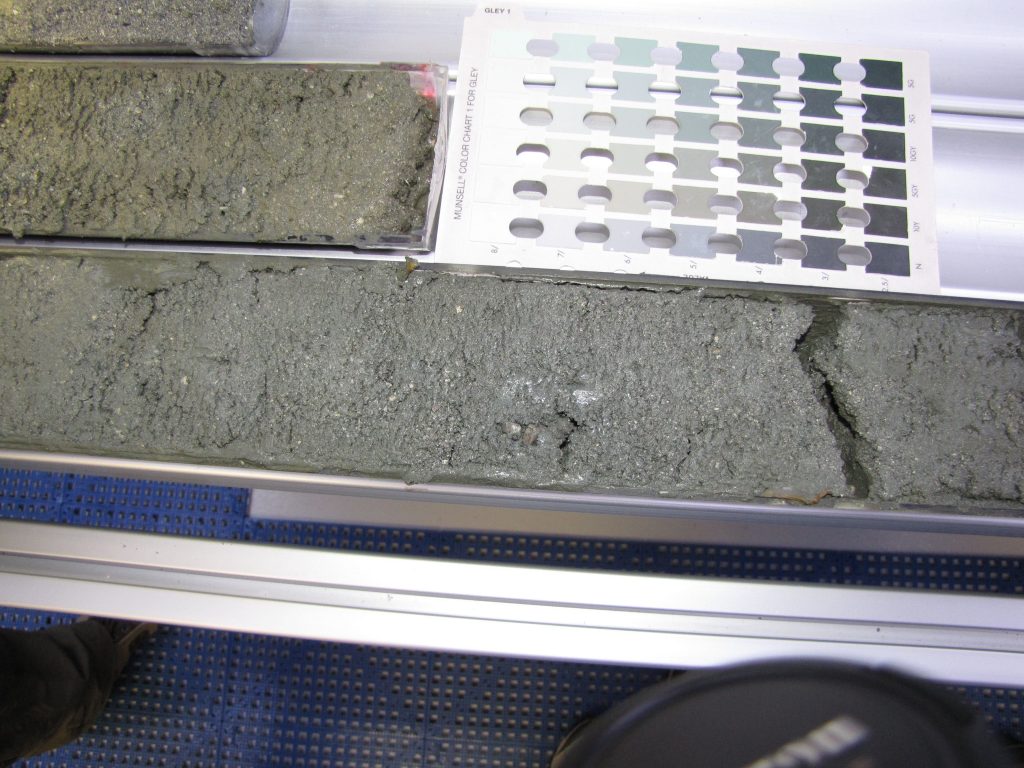
What is a Core?
I’d seen pictures of cores. I’d seen the data and analysis of cores. But to see a core fresh from underground is very exciting. Everyone was out on deck watching the first core arrive. Mud, oh lovely mud. What color is it?
Drilling is like pushing a giant straw through layers of cake or jello. There are lots of teaching activities to do that show young people how coring works. The first core on deck is from the top 9.5 m, just like at the top of the straw will be the top of the cake with frosting. Then the second core is from a depth of 9.5 to 19.0 meters below the seafloor. And so on. We can’t put a giant straw down, so we use a shorter one – only 9.5 m (about 30 feet). On this cruise, we are in shallow water (138 m) and are drilling to about 1000 m below the seafloor. In the end, we will have only 1138 m of drill pipe out. Here is a generic view coring and sampling.

We end up with lots and lots of tubes of rock. First, the organic chemists come and take gas samples. We want to know how much methane is in the rock for both the science and safety. The core is cut into sections of 1.5 m which are much easier to handle and move around in the labs. The whole core is run through many tests and then sliced in half the long way. Half is for the archive and half is for sampling by the scientists on board. Some whole sections (8 cm or so) are also removed for chemical analysis.

I love looking at the spilt core. So far it has been pretty much the same color and grain size. We found some wood and large shells that were preserved quite well. Very cool. The wood will be analyzed for dating. Some of the large shells were found in some of the extra material that is not really part of a core. I’m going to bring them back and get one of my high school interns to identify the shells.


Here is the recent daily science report:
LOCATION: U1379 (CRIS-4A) Lat. 8º 40.8496’ N Long. 84º 2.0169’ W
Cores U1379C-14H to U1379C-32X (78.70-236.26 mbsf) were retrieved with an average recovery rate of 87.53%. We are still coring a very monotonous sequence of mainly greenish gray, extremely compact, silty clay to clay, which is very rarely interrupted by sandy layers sometimes containing shell fragments and carbonate concretions. Generally, the amount of shell fragments within the normal background sedimentation decreases from the upper part of the sequence toward the lower parts and overall the clay is very barren in terms of its nannofossil content. The material we are coring is still late- to mid-Pleistocene as indicated by the nannofossils.
You can read the daily and weekly reports.
Here is an activity for high school students, but I think everyone can learn a little more about cores from it. http://www.oceanleadership.org/education/deep-earth-academy/educators/classroom-activities/grades-9-12/what-is-a-core/
Here are a few IODP Drilling Highlights and Statistics, June 2004 to March 2010 (through Expedition 324)
Meters Feet Miles Geographic area & cruise
Deepest hole penetrated: 1,507 4,943 0.94 E Pacific Ocean, Exp 312, Hole 1256D
Shallowest water depth: 95.5 313 0.59 southern Pacific Ocean, Exp 317
Deepest water depth: 4,479 14,695 2.78 central Pacific Ocean, Exp 321
Most core recovered on a cruise: 5,741 18,835 3.57 Bering Sea, Exp 323
Total core cored: 35,049 114,990 21.8 Total core recovered